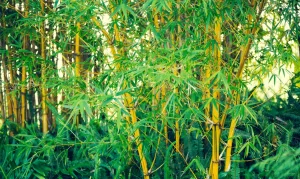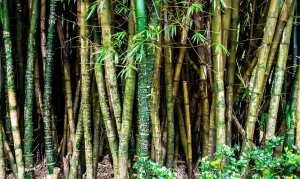How Long Do Bamboo Plants Live? Bamboo is well-known for its rapid and tall growth, aggressive distribution, and incredible sustainability. However, some of the features of bamboo remain a mystery. Many readers and consumers, for example, want to know how long bamboo lives.
Bamboo is a perennial grass, which means it grows year after year rather than dying off at the end of the year, as annual grasses such as wheat and corn do. Most bamboo varieties can live for many decades, and some can live for a century or more. Bamboo species are all, or almost all, monocarpic, which means they bloom once and then die. However, in the case of Phyllostachys bambusoides, it can take 50, 60, or even 120 years for these bamboos to bloom. Some dwarf bamboo varieties may be able to flower multiple times and continue to grow.
Bamboo is a relatively simple plant to care for. For most gardeners, the most difficult task is keeping it confined. Bamboo, whether it is anything, is a force to be reckoned with. It spreads quickly, grows widely, and lives a long time. Bamboo is an excellent choice for a plant that will thrive in your backyard, full of life and bursting with greenery. If, on the other hand, you’re waiting for your neighbor’s bamboo to die, don’t hold your breath.
Individual culms can age and die after 5 or 10 years, yet the plant as a whole can outlive everything else in your yard. (Unless you’re cultivating Giant Sequoias). The newer culms will crowd out the older ones as the bamboo grows and spreads. Going in and cutting out some of the older canes once in a while is a good idea for the plant’s health and appearance.
Contents
Flowering And The Bamboo Life Cycle
The flowering period of most bamboo is the most significant factor in determining its life span. And one of the most enigmatic aspects of bamboo is its flowering. And it differs significantly between species.
When we think of bamboo, we envision long, elegant poles that can be deep green, buttery yellow, or even striped. And we envision thick trees with delicate green leaves. The canes sway in the wind, and the leaves rustle in harmony. However, bamboo flowers are unlikely to reach our minds. In most instances, the flowers are unobtrusive, resembling a strand of rye rather than something you’d find in a spring bouquet. They are uninteresting to us, but they are essential to the plant’s life cycle.
Flowering is the last act of life for the vast majority of bamboo species. They are monocarpic, which means they only bloom once. Most grains and vegetables, like bamboo, bloom, go to seed, and die like an annual plant. These bamboos, however, are not annuals. They will live for decades or more before flowering and going to seed.
Phyllostachys bambusoides appear to be the longest living bamboo species, with a flowering interval of 120 years. Botanists and bamboo experts from Asia and around the world continue to investigate the unusual phenomenon of bamboo flowering, but much remains unknown. Gregarious flowering is one of the most interesting habits. This means that all members of a given species would bloom at about the same time, anywhere in the world. This potentially endangers the entire ecosystem. That is, if they do not successfully reseed at this time due to a drought or other natural disaster, the entire species could be extinct.
Other species, such as the well-known Bambusa oldhamii, rarely bloom. Moreover, despite extensive studies, no one knows how much or why oldhamii flowers. It does not tend to occur on a regular basis, and many speculate that flowering in this species may be stress-induced. Fargesia bamboos seem to have a very frequent and consistent flowering cycle, with a lifespan ranging from 40-60 years, depending on the species. They even bloom profusely.
Limited observations of the genus Sasa indicate that some of these small yet tenacious plants may be polycarpic, meaning they may flower several times before dying. This would be highly unusual for bamboo, but not unlikely, given that bamboo flowering activity is only partly understood.
When The Bamboo Dies?
When the bamboo flowers and goes to seed, it may be a disaster, but it may also be an opportunity. As previously stated, if all members of the species go to seed at the same time, it is important that any of those seeds replant successfully.
In Mizoram, northeast India, the situation is much direr. Every 50 years, the Melocanna baccifera (a local bamboo species) flower and goes to seed, triggering an unexpected chain of events. Back in 1959, an unexpected bumper crop of bamboo seed provided a bountiful harvest for the local rodent population. Because of the sudden rise in the food supply, the number of rats skyrocketed. When the bamboo grain ran out, the starving rats started to raid human food storage fields and warehouses. As a result, this region of India experienced a widespread famine.
Under better conditions, bamboo gardeners who see their plants blooming should certainly log the case. It’s on Instagram! This isn’t something that happens all the time. More importantly, they should try to collect the seeds once they have completely ripened, dried, and are ready to harvest. Cross-pollination is also possible in a small bamboo garden, resulting in a new bamboo cultivar. What a fantastic idea! So, once your bamboo blooms, remember to save the seeds.
Life Span Of Bamboo Culms: How Long Does Bamboo Plants Live?
Individual bamboo poles, or culms, have a lifespan that differs significantly from the lifespan of the entire plant. Most bamboo culms have a lifespan of 5 to 10 years before they lose their virility and begin to dry out. They stop producing new leaves and lose some of their colors at this stage. They are vulnerable to cracking when they dry. It’s a good idea to go in with a hand saw and clean out this dead wood once in a while for the plant’s overall appearance and wellbeing. Dead poles should be cut down to the ground as far as possible.
Chusquea culeou has the longest living culms of any bamboo species. Their life expectancy is expected to be greater than 30 years. Canes of Phyllostachys bambusoides, another long-lived bamboo, can live for up to 20 years.
Bamboo For Long Life
Bamboo is associated with a number of mythic and magical associations with longevity. Bamboo is depicted as the first mode of existence in numerous Far Eastern legends. According to these stories, the first man and woman arose from the empty cavity inside the bamboo pole. The plant’s significance and notoriety in legends and mythology attest to its tenacity and endurance.
Read more about How long to Keep Grow Lights On Plants?
Farmers and builders have discovered that you can harvest the poles of a bamboo plant indefinitely, and the plant will live on. You may also be certain that a bamboo structure can outlast any other primitive structure. Bamboo’s longevity extends from the forest to the building process. And if you ever attempt to contain or remove a bamboo plant, you will discover that it is a tenacious foe. Since the true source of the bamboo’s livelihood is in its roots.
The Robust Rhizomes Of Bamboo
If you ever try to shorten the life of a bamboo plant, you’ll quickly discover that it’s not so easy. Saw off any majestic pole to make a fence or a shack, and those roots can only grow stronger. If you try to dig those rhizomes out with a shovel, you’ll find yourself in the oldest fight of all: man vs nature. This is a plant that clearly desires to exist. And those underground rhizomes exhibit the will to live in a spectacular way.
We like to classify the approximately 1,500 varieties of bamboo known to botanists into two broad categories. We categorize them as runners or clumpers based on the characteristics of their rhizome systems. Running bamboo sends out long, thin rhizomes that run horizontally away from the plant’s base. You can break down the culms and dig out all the rhizomes you can find, but if you miss a few, they will most likely regrow.
Clumping bamboos, on the other hand, have rhizomes that are thicker and shaped like u. Instead of sending long roots away from the heart, these rhizomes usually curve upward to send up new shoots. In this manner, they are easier to contain and, if possible, much easier to extract. Of course, when dealing with timber bamboo, removal is not a simple process.
Conclusion: How Long Does Bamboo Plants Live?
Bamboo has become the backbone of much of the world’s rural life and will continue to be so as the world’s population grows. Bamboo will continue to play an important role in the growth of businesses and the transformation of rural environments in all developing-world regions where it develops.



